BMW M5
| BMW M5 | |
|---|---|
.jpg) BMW F90 M5 alongside the E28 M5 at the BMW Techno Classica at Essen, Germany. | |
| Overview | |
| Manufacturer | BMW M GmbH |
| Production | 1985–present |
| Body and chassis | |
| Class | Executive car (E) |
| Layout |
Front-engine, rear-wheel-drive (1985–2016) Front-engine, four-wheel-drive (2017–present) |
| Related |
BMW 5 Series BMW M6 |
The BMW M5 is a high performance variant of the 5 Series executive car built by the Motorsport division of BMW. The first incarnation of the M5 was hand-built in 1986 on the 535i chassis with a modified engine from the M1 that made it the fastest production sedan at the time.[1] Versions of the M5 have been built from subsequent generations of the 5 Series platform.
E28 M5 (1985–1987)
| BMW E28 M5 | |
|---|---|
.jpg) | |
| Overview | |
| Production |
1985–1987 2,191 produced |
| Assembly |
Garching, Germany Rosslyn, South Africa |
| Designer | Claus Luthe |
| Body and chassis | |
| Related | BMW 5 Series (E28) |
| Powertrain | |
| Engine |
3.5 L M88/3 I6 3.5 L S38B35 I6 (North America Only) |
| Transmission | 5-speed manual |
| Dimensions | |
| Wheelbase | 2,624 mm (103.3 in) |
| Length |
4,620 mm (181.9 in) 4,800 mm (189.0 in) (with US bumpers) |
| Width | 1,699 mm (66.9 in) |
| Height | 1,415 mm (55.7 in) |
| Curb weight | 1,498 kg (3,303 lb) |
The first BMW M5, based on the E28 5 Series, made its debut at the Amsterdam Motor Show in February 1985.[2] It was the product of demand for an automobile with the carrying capacity of a saloon (sedan), but the overall appearance of a sports car. It utilized the 535i chassis with various mechanical changes. Most notably the M88/3 engine that was derived from the engine used in the M1. The cars sold in the United States were equipped with a more emissions friendly evolution of this engine known as the S38. At its launch, the E28 M5 was the fastest production sedan in the world.[1]
The first generation M5 was hand-built in Preussenstrasse/Munich prior to the 1986 Motorsport factory summer vacation. Thereafter, the M5 production was moved to Daimlerstrasse in Garching where the remainder were built by hand.[3] This continued production would eventually lead to a class action lawsuit that was settled with vouchers being given to car owners. Chicago Clearing Corporation served as a market maker for these $4,000 vouchers that were officially issued in 1993.[4]
The M5 was produced in four different versions based on intended export locations. These were the left-hand drive (LHD) Euro spec, the right-hand drive (RHD) UK spec, the LHD North American (NA) spec for the United States and Canada, and the RHD South African (ZA) spec.
The European and South African M5s utilised the M88/3 engine which produced 213 kW (286 hp). North American 1988 models used the S38B35 engine which was equipped with a catalytic converter and produced 188 kW (252 hp).

Production of North American specification M5s commenced in November 1986 and ended in November 1987.[3] Aside from 96 cars which were assembled in kit form at BMW's Plant in Rosslyn, South Africa, all E28 M5s were assembled by hand at BMW Motorsport in Garching, Germany.
With a total production of 2,241 units,[3] the E28 M5 remains among the rarest regular production BMW Motorsport cars – after the BMW M1 (456 units), BMW E34 M5 Touring (891 units)[5] and the BMW 850CSi (1510 units).[6]
Specifications
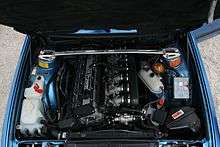
European models European-Spec M5s were available with some options unavailable on US-Spec M5s, such as Water Buffalo leather and a Glass Moonroof. Left-hand drive (LHD) cars were equipped with 185TR390 metric alloy wheels, while right-hand drive (RHD) cars used 16x7.5 alloy wheels. Very early European-Spec LHD M5s had VINs that started with "WBA" instead of the "WBS" designation to indicate BMW Motorsport. It is estimated that no more than 15 M5s were produced with a "WBA" VIN.
United States/Canada models US-Specification M5s were comprehensively optioned: Leather Door Panels, Leather Center Console, Full Trunk Carpeting, Air Conditioning, Power Windows, Power Sunroof, Power Seats, Cruise Control, On-Board Computer, Central Locking and Shadow-line Trim were standard. The United States/Canada Left-hand drive (LHD) cars were equipped with 16x7.5 alloy wheels. The only option on a US-Specification M5 was electrically heated front seats which were standard equipment on Canadian-Market cars. The only paint colour available was "jet black".
E34 M5 (1989–1995)
| BMW E34 M5 | |
|---|---|
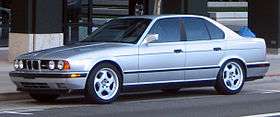 | |
| Overview | |
| Production |
1989–1995 12,254 produced |
| Assembly |
Garching, Germany Rosslyn, South Africa |
| Designer |
Ulf Weidhase Claus Luthe Ercole Spada |
| Body and chassis | |
| Body style |
4-door saloon/sedan, 5-door estate/wagon |
| Related | BMW 5 Series (E34) |
| Powertrain | |
| Engine |
3.5 L S38B36 I6 3.8 L S38B38 I6 |
| Transmission |
5-speed manual 6-speed manual |
| Dimensions | |
| Wheelbase | 2,761 mm (108.7 in) |
| Length | 4,720 mm (185.8 in) |
| Width | 1,750 mm (68.9 in) |
| Height | 1,392 mm (54.8 in) |
| Kerb weight |
|
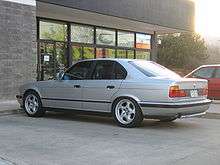
.jpg)
The E34 generation of the M5 was produced from September 1988 to August 1995. Hand-built at BMW M GmbH in Garching, Germany, it was based on the E34 chassis produced at BMW's Dingolfing plant.[7] After arriving as a painted shell from Dingolfing, the M5 was assembled by a team of M employees and took about two weeks.[8] Only the South African M5 was entirely assembled at the Rosslyn, South Africa assembly plant from complete knock down kits supplied from Garching, Germany.
Cosmetic changes to the exterior from the standard E34 include unique front and rear bumpers and side rocker panels, contributing to a drag coefficient of 0.32 (from 0.30), while the inside saw upgrades that include an M5-specific shifter surround and rear headrests.
The E34 M5 released with the S38B36 engine which produced 232 kW (315 PS; 311 bhp) at 6,900 rpm and 360 N⋅m (266 lb⋅ft) at 4,750 rpm.[9]
In the second half of 1991, engine displacement was increased to 3.8 litres with the S38B38, with exception to North America and South Africa, which continued with the 3.6 litre engine due to emission laws. Power increased to 250 kW (340 PS; 335 bhp)[10], and the ignition changed to a distributor-less system with each cylinder having an individual coil. BMW also used a dual-mass flywheel in place of the single in the 3.6 for a smoother idle and throttle input at the expense of response. The standard self-leveling suspension (SLS) system, which maintained a constant ride height in the rear, was replaced with Electronic Damper Control (EDCIII+), an electronically controlled and hydraulically regulated system that can switch between comfort "P" setting and a more track-oriented "S" setting. A 6-speed manual transmission was made standard on the last model year (1995), which added an overdriven top gear. The E34 M5 was the last M5 to feature an engine with a historical link to a BMW Motorsport racing engine.[11]
.jpg)
.jpg)
In 1992, a five-door Touring version (estate/wagon) was introduced in LHD form,[12] with 891 cars made. The E34 M5 Touring was BMW M Division's first wagon, as well as the last hand built M car made.
Wheels
The M5 came with an unusual wheel design. From 1988–1992 the M5 featured the three-piece Style 20 "M-System" wheels, which consisted of directional bolted-on wheel covers and fin assembly in front of the wheel itself. The wheel was a forged, black 5-spoke alloy, offered either as square 17x8 et20 setup or staggered with 9-inch wide wheels to the rear as an option. The intent of the M-System cover was to divert heat from the brake assembly to increase cooling. In 1992 BMW changed the design to the "M-System II" (nicknamed "throwing stars") which improved brake cooling from the combination of the larger openings and fins placed in the driving direction.[13] In May 1994, the M5 switched to 18-inch Style 37 "M Parallel" wheels that did away with the cover entirely.[7]
Performance
- 89–92 (Euro) I6-24v 3.6 L
- 0-60 mph (97 km/h): 6.3 s*[9]
- Top speed: 155 mph (250 km/h)(electronic limited)
- 92–95 (Euro) I6-24v 3.8 L
- 0-60 mph (97 km/h): 5.9 s*[14]
- Top speed: 155 mph (250 km/h)(electronic limited)
- 91–93 (US) I6-24v 3.6 L
- 0-60 mph (97 km/h): 6.1 s*[15]
- Top speed: 155 mph (250 km/h)(electronic limited)
* (Manufacturer claimed)
Special versions
There were four special editions of the E34 M5. The Cecotto, Winkelhock and 20 Jahre editions which were offered as LHD Euro specification models while the RHD UK Limited edition was only sold in the United Kingdom.[7]
Cecotto Edition
In 1991, BMW asked two race drivers to design their "ideal" version of the E34 M5. One of the drivers, Johnny Cecotto, wanted a host of luxury items fitted on the M5, including Nappa leather for the steering wheel and heated seats. A total of 22 Cecotto E34 M5s were produced with options of having either Lagoon Green metallic (266) and Mauritius Blue metallic paint (287) and Light Parchment or Light Silvergrey for the interior.[7]
Winkelhock Edition
BMW also tasked touring car driver Joachim Winkelhock to come up with his own version of the car. The manufacturer wanted a lightweight E34 M5 stripped of some amenities. His ideal lightweight version M5 featured a smaller battery, the reduced US-spec 81L fuel tank, reduced sound deadening, and deletion of non-essential items such as rear headrests, vanity mirrors, rear window switches and foglights. The Recaro front seat design, suede-covered 385mm M-Technic II steering wheel, shift knob and parking brake handle, and red seatbelts were similar to those on the BMW E30 M3 Sport Evolution. A total of 51 Winkelhock E34 M5s were produced with the options of having Jet Black (668) with contrasting lower body panels in Sterling Silver metallic paint (244).[7]
20 Jahre Motorsport Edition
To celebrate BMW Motorsport's 20th anniversary, BMW built 20 specially equipped Euro-spec 3.8L M5s in late 1992. Offered only in Mugello Red (274), the anniversary edition had a number of aesthetic trim upgrades such as carbon fiber dash panels, red seat belts embroidered with "BMW Motorsport," and M-Technic rear-view mirrors. Unique seat center & door trim fabric were matched with Alcantara, which was also used on the steering wheel, shift lever & parking brake lever. [16]
UK Limited Edition
To commemorate the end of right-hand drive E34 M5 production, 50 examples of the E34 M5 Limited Edition were assembled between March and June 1995 in one of two unique color and trim combinations: Rosso Red metallic (369) with a Champagne extended leather interior and natural poplar wood trim (15 built) or Orinoco metallic (406) with a Bicolor Petrol and Mint extended leather interior and graphite bird's-eye maple wood trim (35 built). Each E34 M5 Limited Edition is equipped with the three-spoke sport steering wheel, Shadowline trim, power sunroof, power front seats, headlight washers and manual air conditioning. A numbered plaque appears on the center console.[7][17]
Additionally, 20 M5 Touring "Elekta" models were assembled for distribution in Italy. These were finished in either Sterling Silver over Marine Blue leather, or British Racing Green over Tobacco leather. All were made in 1995, and featured extended leather interior as well as unique, numbered shift knobs. It is debated as to whether or not these cars constitute a true special edition as they were ordered directly by a group of Italian BMW dealers.[7]
Convertible
An M5 convertible variant was considered by executives at BMW M and keeping that in view, a fully functioning prototype was constructed. The prototype featured the 3.5 litre S38B36 straight-six engine, a 2,761 mm (109 in) long wheelbase and a slightly raked windshield than that of a normal M5. Due to an apparent lack of structural rigidity caused by the removal of the roof, steel reinforcements were added under both side valance panels. The car also featured a power-operated cloth roof, which was said to increase the curb weight by roughly 100 kg (220 lb), and front seats with integrated seatbelts were borrowed from the E31 8 Series. The prototype was never given the green light or production due to financial considerations.[7]
Motorsport
VDS Racing Adventures[18] has used an E34 M5 in endurance racing, where weight and nimbleness is less important than in sprint racing. The car features many one-off components, including a wide-arch fibreglass bodykit, but the engine is based on the 3.8-litre S38 straight-six and is almost standard, producing approximately 260 kW (354 PS; 349 bhp). It has also raced in the Belgium Belcar Championship, where it was runner up in 2001.
An E34 M5 was raced in the Australian 1992 Bathurst 12 Hour Production Car endurance race, placing 2nd overall, and 1st in its class. It was driven by former F1 champion Alan Jones, Neville Crichton, and BMW Touring car driver Tony Longhurst.
E39 M5 (1998–2003)
| BMW E39 M5 | |
|---|---|
_(cropped).jpg) | |
| Overview | |
| Production |
1998–2003 20,482 produced |
| Assembly | Dingolfing, Germany |
| Designer |
Ulf Weidhase Joji Nagashima |
| Body and chassis | |
| Body style | 4-door saloon/sedan |
| Related |
BMW 5 Series (E39) BMW Z8 Ascari KZ1 |
| Powertrain | |
| Engine | 4.9 L S62 V8 |
| Transmission | 6-speed manual |
| Dimensions | |
| Wheelbase | 2,830 mm (111.4 in) |
| Length | 4,783 mm (188.3 in) |
| Width | 1,801 mm (70.9 in) |
| Height | 1,412 mm (55.6 in) |
| Kerb weight | 1,826 kg (4,026 lb) |
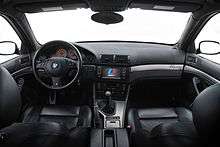
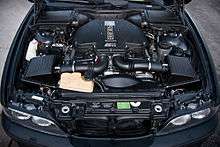
_-_Flickr_-_The_Car_Spy_(15).jpg)
The E39 M5 had a significant increase in power and was produced in much greater numbers than the previous generations.[19] Unlike its predecessors, the M5 was produced on the same assembly line as the regular 5 Series models at the Dingolfing factory in Germany.
Introduced in 1998 at the Geneva Motor Show, production did not begin until late October of that year. A total of 20,482 E39 M5's were made from 1999 to 2003. BMW M produced three versions of the E39 M5, the European LHD and RHD versions, and the North American specification version.
Powertrain
The E39 M5 utilises the S62 V8 engine also shared with the Z8, which produces 294 kW (400 PS; 394 bhp) at 6,600 rpm and 500 N⋅m (369 lb⋅ft) of torque at 3,800 rpm.[20]
All E39 M5s came equipped with a Getrag type D six-speed manual transmission which provides the following gearing ratios:[20]
| 1st gear | 2nd gear | 3rd gear | 4th gear | 5th gear | 6th gear |
|---|---|---|---|---|---|
| 4.23 | 2.53 | 1.67 | 1.23 | 1.00 | 0.83 |
The E39 M5 utilises the same transmission as the E39 540i, but with some changes to cope with the extra power produced by the S62 engine. The differences consist of a reinforced clutch, a rear differential utilising a shorter 3.15:1 ratio, and a limited slip differential with 25% maximum locking.
Chassis
The E39 M5's suspension shared its basic aluminium-intensive MacPherson strut/multi-link design of the V8 engined E39 5 series. However, several changes were made by BMW M. Reduced spring height, 23 mm (0.9 in) lower. A specific shock valving, thicker front and rear anti-roll bars, polyurethane auxiliary springs, and steel balljoints.
Although the six-cylinder E39 models use rack-and-pinion steering, the M5 (and other V8 models) retains the recirculating ball steering system, as used by previous generations of M5. A quicker steering ratio of 14.7 was used, compared with 17.9 for other V8 models.[21] It featured a Servotronic vehicle-speed-sensitive power assist which provides two levels of resistance controlled via console mounted Sport button. The Sport button also adjusted the electronic throttle butterflies for more sensitive response. The E39 M5 is equipped with four-wheel vented disc brakes measuring 345 mm (13.58 in) in diameter in front and 328 mm (12.91 in) in diameter in the rear.[20] On European-specification models, the rotors are of a "floating" two-piece design for reduced risk of cone distortion. Their lower unsprung weight improves ride quality and traction on bumpy surfaces as well. Anti-lock brakes, EML (fly-by-wire) throttle control and Dynamic Stability Control (DSC) were standard.
Updates
During its five years in production, there were some cosmetic changes in 2001 to include:[22]
- Revised headlights incorporating illuminated "Corona Ring" design (incandescent plastic rings surrounding the headlights, often referred to as "Angel Eyes").
- Jewel tone Celis tail light design
- Park Distance Control sensors in the front bumper (previously in rear only)
- Thicker three-spoke M steering wheel identical to the one fitted to the E46 M3
- Grey instrument panel
- Wireless carphone with new design (previously with cable connection only)
- Improved solar sensor for standard automatic climate control
- Revised navigation/audio unit with larger (6.5-inch) monitor (Standard on US Spec 2001–2003)
- Rear head protection airbags added
- Second-generation M Mobility tyre repair system in place of earlier version
- Available M Audio System with special tweeters, Kevlar/carbon coaxial speakers and two subwoofers behind the rear console
- Alcantara headliner included with Extended Leather interior (previously only included with Complete Leather)
For the subsequent two model years, changes were limited to the addition of new exterior colors (from 9/01 production) and the upgrade to a DVD-based navigation system (from 9/02 production).
In NA, 2002 and 2003 models have the 'Auto Headlamps' feature as standard, they were previously optional..
Performance
The official BMW of North America statement (mentioned in the 2003 brochure) for the acceleration time from 0–60 mph is 4.8 seconds. It is electronically limited to a top speed of 250 km/h (155 mph).[23][24]
Unrestricted the E39 M5 has in some testing reached a top speed in excess of 300 km/h (186 mph).[25]
The E39 M5 recorded a Nurburgring lap time of 8:20[23] and a Top Gear power lap of 1:27.0.
E39 M5 Touring
Although an E39 M5 Touring was considered, and at least one prototype was constructed (in Titanium Silver with a Black Exclusive leather interior), BMW M decided not to produce an E39 M5 Touring due to financial considerations. In February 2010, as part of BMW's 25th Anniversary of the M5, they revealed this prototype M5 touring[26] along with an E34 M5 Cabriolet,[27] which also was never produced (a Cabriolet model would be spun off as part of the E63/64 6 Series and M6 for the next generation of the 5 Series and M5).
E60 M5 (2005–2010)
| BMW E60 M5 | |
|---|---|
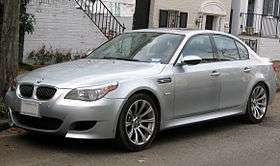 | |
| Overview | |
| Production |
2005–July 7, 2010 19,564 saloons produced 1,025 estates produced |
| Assembly | Dingolfing, Germany |
| Designer |
Karl John Elmitt Davide Arcangeli |
| Body and chassis | |
| Body style |
4-door saloon/sedan, 5-door Touring (estate/wagon) |
| Related | BMW 5 Series (E60) |
| Powertrain | |
| Engine | 5.0 L Odd firing S85 V10 |
| Transmission |
6-speed manual (US&Canada only) 7-speed SMGIII |
| Dimensions | |
| Wheelbase |
saloon: 2,889 mm (113.7 in), Touring: 2,880 mm (113.4 in) |
| Length |
4,855 mm (191.1 in) 2008–2010: 191.5 in (4,864 mm) |
| Width | 1,846 mm (72.7 in) |
| Height |
saloon: 1,469 mm (57.8 in), Touring: 1,512 mm (59.5 in) |
| Kerb weight |
saloon: 1,855 kg (4,090 lb), Touring: 1,955 kg (4,310 lb) |
.jpg)
.jpg)
The E60 M5 was introduced in 2005, with an uneven firing V10 engine and 7 speed sequential manual gearbox linking the car with the BMW Sauber Formula One program.[28] The E60 M5 was the world's first production sedan to feature a V10 petrol engine. A 7-speed sequential manual transmission (SMG III) was available, and a 6-speed manual transmission was available for the US only. As with some of its predecessors, the E60 variant of the M5 was both the quickest and fastest 4-door sedan in the world at the time of its release.[29]
Other unique features include a wider track, unique body panels, a color heads up display featuring navigation, control messages, speed, rpm and gear selection information, automated seat side bolsters, heated/ventilated seats and power rear curtain. The larger, flared front guards on either side also featured cooling vents, reminiscent of the 1970s BMW CSL. The wheels were of a standard 19" diameter and the car featured quad exhaust pipes at the rear.
The E60 M5 was the most successful M5 produced, despite being on the market for one year less than the E39 M5. During its five-year run, 20,548 units were built composing of 19,523 saloons and 1,025 estates. 8,800 were sold in the U.S., all of the sedan variety. Great Britain and Ireland claimed 1,776 examples, followed by BMW's home market of Germany with 1,647 units, and 1,357 were sold in Japan. Italian enthusiasts claimed 512 units, and 339 examples were sold in Australia.[30]
Powertrain
The E60 uses an odd firing V10 which has won multiple World Engine of the Year awards, S85 engine produces 373 kW (507 PS; 500 bhp) at 7,750 rpm[31] and 520 N⋅m (384 lb⋅ft) of torque at 6,100 rpm. The engine and transmission were designed from scratch for this particular model; they are not based on or feature on any other models with the exception of the E63/64 M6.
The BMW M5, along with the E63/64 BMW M6, were designed to use the new Getrag SMG III single-clutch seven-speed semi-automatic transmission, that performs gear shift in 65 milliseconds. The SMG III sequential manual includes features like a hill holder, a designated drive program for steep climbs and descents, and a downshift assistant, which briefly dips the clutch to avoid destabilizing wheel spin as well as a pseudo-automatic mode.[32] However, many reviews have observed the automatic mode of the transmission at low or frequent stop start speeds as being less smooth than that of a conventional automatic transmission.[33][34][35][36][37][38]
Based on North American demand, BMW announced in October 2006 that a six-speed conventional manual transmission would be available in North America; this became the base transmission in these markets while SMG III was available as an option.[39] The six-speed manual M5 was marginally slower in certain tests, as the dynamic stability control could not be disengaged unlike the SMG version.[40] The release of a Service Bulletin in November 2007 for a retrofit allowed DSC to be disabled as well as the function being implemented into the introduction of the 2008 model year M5 as well as the M6.[41] The SMG III includes the "Launch Control" feature. However, the US spec vehicles have a reduced launch control of 1500 rpm instead of the 4000 rpm that the European models received.
The M5 features several Formula One-inspired engine and transmission controls.[19] There is launch control, which allows maximum performance standing starts automatically. The Getrag SMG III single-clutch semi-automatic transmission has the option of changing to either automated or manual, as well as the speed at which shifts are completed (there are 11 shift programmes in total, forming what BMW calls Drivelogic). Manual shifting can be done with either a console shifter, or the steering wheel mounted shift paddles, both of which are fitted to all SMG M5s. The console shifter is the type used on manumatic transmissions; tipping it backward (toward the "+") shifts up, while a forward tip (toward the "-") shifts down. The shifter can be moved to the left to access neutral and reverse. The car also features a "power" button on the navigation panel (labeled "M") which offers access to three modes: P400 (limiting the engine to 294 kW (400 PS; 394 bhp) for daily driving use), P500 (unleashes the full 373 kW (507 PS; 500 bhp), and P500 S (for full power and sharper throttle response, selectable only from the "M Drive Settings" in the iDrive menu). P400 is the default start-up mode, the P500 modes are preselected using iDrive and then activated from P500 S using the "M" button.
Performance
BMW stated the car to reach 0–100 km/h (0–62 mph) in a time of 4.2 seconds and an absolute (de-limited) top speed of 328 km/h (204 mph) Motor Trend's comparison test found that while the E55 AMG had recorded a faster 0–60 mph time of 4.2 seconds versus the (inhibited) US-launch control equipped M5's 4.5 seconds, the M5 had superior driving dynamics.[42]
In the Australian publication Wheels magazine in July 2005 recorded a 0–100 km/h (0–62 mph) time of an early, 2004-built E60 M5 of 4.4 seconds. The E60 M5 Sedan shared its underpinnings with the E63 M6 Coupe, with the M6 being lower to the ground and slightly lighter with a carbon fibre roof.[43][44]
The E60 M5 recorded an official lap time of 8:13 at the Nürburgring [45] and recorded a Top Gear power lap of 1:26.2.
The E60 M5 consistently was regarded as the benchmark for super high performance sedans in its class. According to Jeremy Clarkson, former presenter of BBC's Top Gear, “It’s a world of motoring perfection. If you want to take it on...don’t bother. It doesn’t matter what you’ve got. It doesn’t matter what you’ve ever driven. This is quicker, it’s faster, it’s MORE astonishing. You just can’t believe you’re in a big 4-door saloon because it goes and it feels and it SOUNDS like a Ferrari 430, and that’s about the best car I’ve ever driven. The steering, the brakes, the power. And this noise… The driving experience just dominates everything…. It’s an epic car, just brilliant.” Although he was greatly displeased with the car's exterior look and its complicated systems.
E61 M5 Touring (2007–2010)
The E61 M5 Touring was introduced in 2007, only the second M version of the 5 Series Touring after the E34. It shares the same drivetrain with its saloon sibling, and serves as a rival to the Audi RS6 Avant and Mercedes-Benz E63 AMG Estate. The Touring was never offered for sale in North America.
.jpg)
_rl_2008.jpg)
F10 M5 (2011–2016)
| BMW F10 M5 | |
|---|---|
.jpg) | |
| Overview | |
| Production | 2011–2016 |
| Model years | 2012–2016 |
| Assembly | Dingolfing, Germany |
| Designer |
Ulf Weidhase Jacek Fröhlich |
| Body and chassis | |
| Body style | 4-door sports saloon |
| Related | BMW 5 Series (F10) |
| Powertrain | |
| Engine | 4.4L S63B44T0 twin-turbo V8 |
| Transmission |
7-speed dual clutch 6-speed manual (US&Canada only) |
| Dimensions | |
| Wheelbase | 2,964 mm (116.7 in) |
| Length | 4,910 mm (193.3 in) |
| Width | 1,891 mm (74.4 in) |
| Height | 1,451 mm (57.1 in) |
| Kerb weight | 1,945 kg (4,288 lb) |
_(cropped).jpg)
.jpg)
The F10 M5 was released to the public at the 2011 Frankfurt Motor Show, and went on sale in November 2011.[46] Compared to the previous M5, the F10 M5 has improved fuel economy but is larger, heavier, has engine noise played through its audio system and has a lower top speed compared to the naturally aspirated E60 M5 V10 it replaces.
For the 2014 model year, the BMW M5 Competition Package was made available. Compared to the standard M5, the Competition Package has the following changes; horsepower increased, and a revised suspension (bushings, springs, dampers, sway bars) which lowers the car 10 mm. Direct rivals include the 2014 Mercedes-Benz E63 AMG S Model.[47]
Powertrain
The F10 M5 uses a 4395 cc variation of the S63 4.4L V8 engine called the S63B44TÜ, which produces 412 kW (560 PS; 553 bhp) at 6000 – 7000 rpm and maximum torque of 680 N⋅m (502 lb⋅ft) from 1500 – 5750 rpm.[48] A 7-speed dual-clutch transmission is used, with the option of a 6-speed manual gearbox for the US market.[49]
Handling and braking
The car features standard blue-painted brake calipers, however factory optional carbon ceramic brakes can be identified by a polished gold color paint on the caliper. 19 inch multi spoke wheels and 20 inch split 5 spoke wheels were available at launch.
In an effort to lower the curb weight of the F10 M5, which is heavier than the E60 it replaced, BMW partnered with SGL group, a carbon fiber manufacturer.[50] Despite this, the F10 still weighs significantly more than the E60 model and has faced criticism from some quarters for this, its relative lack of engine note and lack of steering feel compared to its immediate predecessor.
Official information
On 15 June 2011, BMW released official press information about the F10 M5.[51] Acceleration from 0 to 100 kilometres per hour (62 mph) in 4.4 seconds and top speed is limited to 250 km/h (155 mph), or 305 km/h (190 mph) with the optional M Driver's Package.[51] The car weighs 1,945 kg (4,288 lb), which is 90 kg (198 lb) more than the previous E60/61 model. Average fuel consumption is claimed to be 9.9 L/100 km (29 mpg‑imp; 24 mpg‑US), which is a 31% improvement over the previous generation. An Active M-Differential provides torque vectoring between the rear wheels, while the optional 20-inch light alloy wheels are fitted with 265/35/20 front and 295/30/20 rear Michelin Pilot Super Sport tires. The F10 was discontinued after the 2016 model year, soon to be replaced by the upcoming F90 M5.
The F10's debut was at the Frankfurt Motor Show in September, and in North America at the LA Autoshow on 18 November. The 2012 BMW M5 also made an appearance before September at the M Festival at the Nürburgring 24 Hours endurance race in Germany on 23 June, the Goodwood Festival of Speed, and was shown to select members of the M Driving Experience at the Salzburg Ring in Austria. The car has a reported lap time of 7:55 around the Nürburgring race track, which is 18 seconds faster than its V10 predecessor.[52]
Special versions
To celebrate BMW M5 30th age anniversary, BMW had built 300 special edition, named "30 Jahre BMW M5". All 300 cars came in BMW special edition paint in the Individual color shade Frozen Dark Silver metallic.
Inside, the “30 Jahre M5” lettering is embroidered on the front door sill finishers and plaque bearing “30 Jahre M5” and “1/300” inscriptions is placed on the dashboard. The “30 Jahre M5” logo is also embroidered into the backrests of all four of the high-performance sedan’s seats.
The power output of the limited edition M5 with Competition Package was raised to 441 kW (600 PS; 591 bhp) and 700 N⋅m (516 lb⋅ft)),[53] allowing it to reach 100 km/h (62 mph) in 3.9 seconds. It is sold globally.
Reception
The car's gearbox and fuel economy cited specifically for their improvements over the previous M5, however its inferior engine note and steering feel compared to the E60 M5, as well as its additional weight, have also been noted.[54][55]
F90 M5 (2017–present)
| BMW F90 M5 | |
|---|---|
 | |
| Overview | |
| Production | 2017–present |
| Model years | 2018–present |
| Assembly | Dingolfing, Germany |
| Body and chassis | |
| Body style | 4-door sports saloon |
| Layout | Front-engine, four-wheel-drive |
| Related | BMW 5 Series (G30) |
| Powertrain | |
| Engine |
4.4 L S63B44T4 twin-turbocharged V8 |
| Transmission | ZF 8-speed automatic |
| Dimensions | |
| Wheelbase | 2,982 mm (117.4 in)[56] |
| Length | 4,965 mm (195.47 in)[56] |
| Width | 1,903 mm (74.92 in)[56] |
| Height | 1,473 mm (57.99 in)[56] |
| Curb weight | 1,855 kg (4,090 lb)[57] |
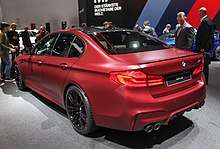

The F90 M5, based on the BMW 5 Series (G30) was presented on 21 August 2017 during the 2017 Gamescom, to promote the upcoming Need for Speed Payback video game followed by a public reveal at the Frankfurt Motor Show (IAA) in September 2017. The car is available to customers from the spring of 2018, exclusively as a sedan. The "M5 First Edition" model, which is limited to 400 units, is only available at the start of sales.
Powertrain
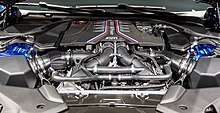
In contrast to the previous generations, the M5 is available for the first time with all-wheel drive. BMW, however relies on a rear biased design that is designed exclusively for driving dynamics with a true rear wheel drive mode included in the all-wheel drive system as well.[58] The engine is an evolution of the S63 from the previous generation.[59] With a power of 441 kW (600 PS; 591 bhp) the new M5 has the same power as the limited edition "Competition Package" and "30 Jahre M5" models of the previous generation, while the torque has been raised to 750 N⋅m (553 lb⋅ft), 70 N⋅m more than the previous M5. The car is now equipped with an eight-speed automatic transmission as opposed to the previous M5's 7-speed dual-clutch transmission (DCT). The F90 is the first M5 to only have an automatic transmission, which has been chosen for its durability and because shift times are not significantly slower than a DCT.[60]
Performance
The F90 M5 accelerates from a standstill to 100 km/h (62 mph) in 3.4 seconds,[61] and to 200 km/h (124 mph) in 11.1 seconds.[58] The top speed is limited to 250 km/h (155 mph), and the delimited top speed is 305 km/h (190 mph) with the optional M Driver's Package.[58] Despite the heavier four-wheel drive, BMW was able to reduce the weight of the new M5 by about 40 kg (88 lb) over the outgoing model.[62]
Competition Package
.jpg)
In May 2018, the M5 Competition package was announced. It retains the same powertrain as the standard M5, but total power output has been increased to 460 kW (625 PS; 617 hp) at 6,000 rpm. Torque remains the same at 750 N⋅m (553 lb⋅ft) between 1,800–5,800 rpm. 0–100 km/h (0–62 mph) acceleration time has also improved and now stands at 3.3 seconds, 0.1 seconds quicker than the standard car along with 0–200 km/h (0–124 mph) acceleration time improving to 10.8 seconds, 0.2 seconds quicker than the standard car. The suspension system has been optimized to improve handling, lowering the car by 7mm. Other exterior changes include the addition of Frozen Dark Silver metallic body colour, new 20-inch Y-spoke bi-colour forged wheels, kidney grille, rear lip spoiler and badges in gloss black and optional "M5 Competiton Package" badges. A special M-sport exhaust system with gloss black tail pipes is standard in order to improve emissions and the car's sound track.[63]
Drift records
The M5 has set two Guinness World Records for Longest continuous vehicle drift of 374.17 km (232.5 miles) breaking the previous record of 144.126 km (89.55 miles) and second record for Longest twin vehicle drift (water assisted) i.e. 79.26 km (49.25 miles) breaking the previous record of 28.52 km (17.72 miles).[64]
See also
| Wikimedia Commons has media related to BMW M5. |
References
- 1 2 "Early History: The BMW 5 Series". BimmerFile. 17 February 2010. Retrieved 16 March 2016.
- ↑ Lewin, Tony (2016). The BMW Century: The Ultimate Performance Machines. Motorbooks. p. 130. ISBN 9780760350171. Retrieved 11 January 2018.
- 1 2 3 "FAQ E28 M5". www.bmwmregistry.com. Retrieved 10 January 2018.
- ↑ "Chicago Clearing Corporation provides cash value to recipients of class-action settlement certificates". archive.org. Archived from the original on 1 July 2003.
- ↑ "This Amazing BMW M5 Wagon Just Sold For $120,000". Road & Track. 11 April 2017. Retrieved 10 January 2018.
- ↑ "The different models of the 8 series (E31)". www.e31.net. Retrieved 10 January 2018.
- 1 2 3 4 5 6 7 8 "E34 M5 FAQ". BMW M Registry. Retrieved 10 January 2018.
- ↑ BMW E34 M5 Promotional Video. BMW NA. 1991.
|access-date=requires|url=(help) - 1 2 "BMW M5 Sedan, 315 hp (E34)". bmw-grouparchiv.de. Retrieved 10 January 2018.
- ↑ "BMW M5 Saloon, 340 bhp (E34)". bmw-grouparchiv.de. Retrieved 10 January 2018.
- ↑ "BMW E34 M5 - The Most Unique M5 Made". m5owner.com. Retrieved 10 January 2018.
- ↑ "BMW M5 Touring (E34)". bmw-grouparchiv.de. Retrieved 10 January 2018.
- ↑ "S38B38 Technical Info" (PDF). Retrieved 6 April 2018.
- ↑ Der BMW M5 (PDF). BMW AG. 1994. p. 19. Archived from the original on 28 September 2007. Retrieved 9 October 2016.
- ↑ The BMW M-Series (PDF). BMW AG. 1990. p. 41. Archived from the original on 29 September 2004. Retrieved 9 October 2016.
- ↑ James Taylor (26 October 2015). BMW M5: The Complete Story. Crowood. p. 183. ISBN 978-1-78500-046-1.
- ↑ James Taylor; Nick Dimbleby (2001). Original BMW M-Series. MBI Publishing Company LLC. p. 107. ISBN 978-0-7603-0898-1.
- ↑ "Motorsport's rare BMW's; M5, 6-Series and 8-Series". germancarmagazine.com. Archived from the original on 16 February 2009. Retrieved 14 February 2009.
- 1 2 "2012 BMW M5 [w/video]". Autoblog.com. Retrieved 2012-09-26.
- 1 2 3 "2001 BMW M5 Specs". JB car pages. Retrieved 19 November 2012.
- ↑ "FAQ E39 M5". www.bmwmregistry.com. Retrieved 23 December 2017.
- ↑ "2001 BMW M5 Review". JB car pages. Retrieved 2012-11-19.
- 1 2 Lewin, Tony. The BMW Century: The Ultimate Performance Machines. Motorbooks. p. 135. ISBN 9780760353042. Retrieved 21 July 2017.
- ↑ Kittler, Eberhard (2001). Deutsche Autos seit 1990, vol.5. Stuttgart: Motorbuch. p. 187. ISBN 3-613-02128-5.
- ↑ "Rund - na und? Der Übergangs-5er von BMW". auto-motor-und-sport.de. Retrieved 30 August 2017.
- ↑ "BMW M5 Touring E39: One-Off Station Wagon Prototype Also Revealed by BMW". Carscoops. Retrieved 29 September 2016.
- ↑ "Uber Cool: BMW M5 E34 Convertible Revealed After 20 Years". Carscoops. Retrieved 29 September 2016.
- ↑ "2012 BMW M5 First Drive Review". autoblog.com. Retrieved 4 July 2017.
- ↑ "2007 Audi S6 vs. 2006 BMW M5 vs. 2007 Mercedes-Benz E63 AMG – Road Test & Review". Motor Trend. 13 December 2010. Archived from the original on 29 June 2011. Retrieved 10 August 2011.
- ↑ "E60 BMW M5 Production Ends Ahead Of F10 BMW M5 Arrival – Australian specifications". Themotorreport.com.au. 8 July 2010. Retrieved 3 October 2010.
- ↑ "BMW M5 Sedan Engine and Chassis Technical Data". BMW AG. Archived from the original on 12 August 2008. Retrieved 4 July 2017.
- ↑ "2006 BMW M5 Suspension & Transmission – Automobile Magazine". Automobilemag.com. Archived from the original on 24 August 2010. Retrieved 3 October 2010.
- ↑ "Review: M5's SMG". leftlanenews.com.
- ↑ "BMW M5 : Used". auto123.com.
- ↑ Robert Farago. "BMW M5 Review". The Truth About Cars.
- ↑ "BMW 5-Series M5 (05-10) 5.0 V10 Saloon 4d SMG Owners' Reviews - Parkers". parkers.co.uk.
- ↑ http://www.edmunds.com/bmw/m5/2013/
- ↑ "2012 BMW M5". Road & Track.
- ↑ "2008 BMW 5-Series & M5 Specs & Features". JB car pages. Retrieved 2012-11-19.
- ↑ "2010 BMW M5 Review and Specs". Edmunds.com. Archived from the original on 26 September 2009. Retrieved 3 October 2010.
- ↑ "Modify DSC to allow "DISABLE" for 6sp – The Unofficial BMW M5 Messageboard". m5board.com. Retrieved 2012-08-17.
- ↑ "2005 BMW M5 vs. 2005 Mercedes-Benz e55 AMG – Full Metal Rockets – Luxury Road Test". Motor Trend. Retrieved 7 April 2012.
- ↑ "BMW M5 VS. BMW M6". YouTube. Retrieved 7 April 2012.
- ↑ "2006 BMW M5 vs.2006 BMW M6 – Full Comparison Test at". Road & Track. 19 January 2006. Retrieved 7 April 2012.
- ↑ List of Nürburgring Nordschleife lap times
- ↑ Kable, Greg (4 November 2009). "Next BMW M5: full details". Autocar. Retrieved 13 March 2010.
- ↑ "2014 Mercedes-Benz E63 AMG S vs. BMW M5 Competition Pack". Motor Trend Magazine. 12 November 2013.
- ↑ "The New BMW M5" (Press release). BMW Group. 15 June 2011. Retrieved 16 November 2013.
- ↑ "Rendered: 2012 BMW M5". Insideline.com. 1 February 2010. Archived from the original on 15 October 2010. Retrieved 3 October 2010.
- ↑ Ireson, Nelson (29 October 2009). "BMW Joins Forces With Carbon Fiber Manufacturer For Megacity Vehicle". MotorAuthority. Retrieved 3 April 2010.
- 1 2 "The new BMW M5" (Press release). bmwgroup.com. 15 June 2011. Retrieved 7 February 2016.
- ↑ "2012 BMW M5". TopSpeed.com. 21 June 2011. Retrieved 30 July 2011.
- ↑ "30 years of the BMW M5". BMW PressClub. BMW AG. Retrieved 21 October 2016.
- ↑ "2012 BMW M5 driven". evo.co.uk. September 2011. Archived from the original on 11 October 2011. Retrieved 8 October 2011.
- ↑ Scott Mortara (3 October 2011). "2012 BMW M5 First Drive". Motor Trend.
- 1 2 3 4 DeMattia, Nico (21 August 2017). "F90 BMW M5 vs F10 BMW M5 — Spec and Dimension comparison". Retrieved 29 March 2018.
- ↑ Taylor, James (21 December 2017). "BMW M5 (2018) review: AWD comes to the M badge". CAR magazine. Retrieved 29 March 2018.
- 1 2 3 "2018 BMW M5: 600 HP and All-Wheel Drive for $102,600". roadandtrack.com. Hearst Communications. 21 August 2017. Retrieved 22 August 2017.
- ↑ "New BMW M5 revealed". www.carmagazine.co.uk. Retrieved 24 September 2017.
- ↑ McParland, Tom (22 April 2017). "BMW M Boss Says High-Powered Automatics Will Even Kill Dual-Clutch Gearboxes". jalopnik.com. Gizmodo Media Group. Retrieved 2 April 2018.
- ↑ "Press Kit: The new BMW M5". press.bmwgroup.com. 21 August 2017. Retrieved 24 September 2017.
- ↑ "2018 BMW M5". caranddriver.com. Retrieved 22 August 2017.
- ↑ "The new BMW M5 Competition". www.press.bmwgroup.com. Retrieved 18 May 2018.
- ↑ Pattni, Vijay (9 January 2018). "BMW drifts the new M5 to two world records". TopGear. BBC Worldwide. Retrieved 31 March 2018.
External links
- Yahoo Autos Official Yahoo Autos
- The "30 Jahre M5"
- BMW M5 Official BMW M5 Site
- St. Antoine, Arthur (April 1992). "Magnum Force". Car and Driver: 47–56.
- "BMW 5-Series and M5 Reviews & News". JB car pages. Retrieved 19 November 2012.
| Model | Based | 1970s | 1980s | 1990s | 2000s | 2010s | ||||||||||||||||||||||||||||||||||||
| 8 | 9 | 0 | 1 | 2 | 3 | 4 | 5 | 6 | 7 | 8 | 9 | 0 | 1 | 2 | 3 | 4 | 5 | 6 | 7 | 8 | 9 | 0 | 1 | 2 | 3 | 4 | 5 | 6 | 7 | 8 | 9 | 0 | 1 | 2 | 3 | 4 | 5 | 6 | 7 | 8 | ||
| M1 | Original | E26 | ||||||||||||||||||||||||||||||||||||||||
| 1M | 1 Series | E82 1M | ||||||||||||||||||||||||||||||||||||||||
| M2 | 2 Series | F87 M2 | ||||||||||||||||||||||||||||||||||||||||
| M3 | 3 Series | E30 M3 | E36 M3 | E46 M3 | E90/92/93 M3 | F80 M3 | ||||||||||||||||||||||||||||||||||||
| M4 | 4 Series | F82/83 M4 | ||||||||||||||||||||||||||||||||||||||||
| M5 | 5 Series | E12 M535i | E28 M5 | E34 M5 | E39 M5 | E60/E61 M5 | F10 M5 | F90 M5 | ||||||||||||||||||||||||||||||||||
| M6 | 6 Series | E24 M635CSi | E63/E64 M6 | F12/F13/F06 M6 | ||||||||||||||||||||||||||||||||||||||
| M Roadster | Z3, Z4 | E36/7 M Roadster | E85 M Roadster | |||||||||||||||||||||||||||||||||||||||
| M Coupe | Z3, Z4 | E36/8 M Coupe | E86 M Coupe | |||||||||||||||||||||||||||||||||||||||
| X5 M | X5 | E70 X5 M | F15 X5 M | |||||||||||||||||||||||||||||||||||||||
| X6 M | X6 | E71 X6 M | F16 X6 M | |||||||||||||||||||||||||||||||||||||||